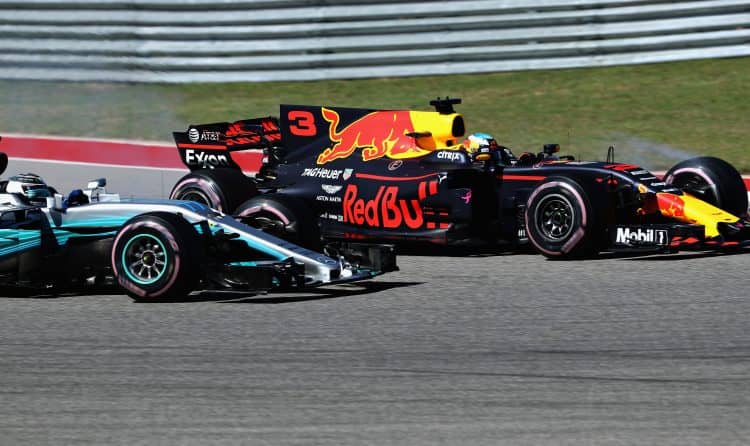366. That, according to IndyCar, is the number of on-track passes that took place during the championship’s frenetic season opener at St Petersburg. By contrast, Formula 1‘s rather sedate opening act featured just five overtakes after the first lap according to Pirelli Motorsport data. With F1 set to map out the future direction of its chassis regulations during this weekend’s Bahrain Grand Prix, and with IndyCar already seemingly cultivating the rewards of a dramatic cut in downforce, surely such an enormous tally of overtakes telegraphs the obvious future direction to Ross Brawn and his team.
However, if Ross was to be presented with such a comparison, he would almost inevitably let out an audible groan. The two figures are not remotely comparable for a plethora of reasons. Albert Park offers fewer passing opportunities than the wide expanses of the St Petersburg runway, tyre degradation proved an infinitely less decisive variable in the F1 opener, and in IndyCar, it would perhaps be natural to expect a greater degree of competitiveness from what is a largely spec-series. If you also factor in the fact that IndyCar incorporates passes made on the first lap and passes on lapped cars into the total, the eye-watering total of 366 competitive overtakes starts to look less credible.
And yet, for any seasoned petrolhead who watched both openers, the truly decisive factor underpinning these chalk and cheese races was starkly apparent. It was certainly no coincidence that whilst F1 perseveres with an aerodynamic blueprint widely associated with a 47% reduction in overtaking, IndyCar was already revelling in its new, lower-downforce aero kit. The change comes on the back of three seasons fielding manufacturer designed aero kits, which have not only been associated with more processional racing but often saw Chevrolet runners enjoy an insurmountable advantage.
The new aero kit is still fitted to the standard-specification Dallara DW12 chassis introduced in 2014, however, the newly standardized aerodynamic package has represented a marked reduction in downforce. It was an aero kit that allowed rookie Jordan King to make an inspired move for the lead on the second caution restart, whilst seasoned champion Will Power span out on the first lap. St. Petersburg was a race of thrills and spills, of slides and spins, punctuated by caution periods and ultimately decided by a thrilling, final lap restart. Meanwhile, in Melbourne, the recovery drives of a pair of highly-motivated Aston Martin Red Bull Racing drivers were met with only frustration and understeer.

Credit: Octane Photographic
Even the might of Lewis Hamilton on a banzai weekend couldn’t penetrate the vast plume of hot, turbulent air cascading from the rear of Sebastian Vettel‘s Ferrari; with the Brit hoisting the white flag with five laps to go. For an F1 season opener that already had its fair share of negative plotlines, Hamilton’s submission was perhaps the most bitter. 2018’s batch of F1 cars have already racked-up two outright lap records from two circuits, but for the second consecutive season, the consequences of this record-setting pace have fallen squarely on the Sunday spectacle. More widely, the negative correlation between downforce and overtaking is one that repeatedly stands up to scrutiny across every branch of motorsport.
The DTM saw exponentially better racing in 2017, having cut the series’ historically high levels of aerodynamic grip; an approach the series is set to continue into 2018 with a further reduction in downforce. Last year’s stellar threeway Nurburgring duel between Marco Wittmann, Paul di Resta and rookie IndyCar prodigy Robert Wickens was a stunning snapshot of the exciting racing the series served up in 2017.
The World Touring Car Championship, by contrast, saw a marked reduction in wheel-to-wheel action following a switch to Citroen‘s preferred DTM-style aero kits for 2014. Similarly, the grippier new Dallara GP3/13 may have succeeded in the series’ aspiration to bridge the cavernous gap between F3 and GP2 machinery, but the 2013 GP3 season passed without a single change of lead after the first lap. Dallara even drafted Kimi Raikkonen as an unlikely development driver for the troublesome new car.
The pattern even continues across F1’s historic tapestry. It should come as no surprise that one of the finest races of the modern era – the Mercedes duo’s remarkable duel in the Bahrain desert in 2014 – came in a season that saw the lowest aerodynamic watermark for over a decade, following the mandatory introduction of low noses and centrally-mounted exhausts. It should also be unsurprising that the most competitive season in recent F1 history, 2012 (a season that saw six different teams take victory), came on the back of a ban on the off-throttle exhaust blown diffuser; a dramatic hit for the top teams who had invested so much in diffuser development. On the flip side, Pirelli recorded a 47% drop in overtaking following last year’s move towards more aggressive aerodynamic regulations.

Credit: Mark Thompson/Getty Images/Red Bull Content Pool
However, there are flies in the ointment. The move to deregulate some of the cars’ aerodynamic parameters went hand-in-hand with a move towards more durable tyre compounds, which Pirelli themselves have cited as a contributory factor on the more processional flavour in 2017. Indeed, tyre degradation has repeatedly proven just as decisive on the on-track action as the aerodynamic wake.
Strikingly, despite exhaust blown diffusers and lap record skimming pace at many circuits, the 2011 season saw an average of 59 passes during a race; the highest of any season during the Pirelli era, and more than twice the number seen in 2017. Pirelli’s old ‘designed-to-degrade’ compounds appear the likely culprit. Conversely, despite the efforts of the so-called ‘overtaking working group’, a dramatic aerodynamic shakeup for 2009 yielded a cut in downforce but without any appreciable improvements in the racing.
Surely it is precisely these kinds of examples that have led Brawn to adopt a cautionary tone when presented with the usual downforce/overtaking correlation. During last year’s Canadian Grand Prix, he argued, “I think there’s a slightly naive view that we should get rid of the aerodynamics and then everything would be wonderful.” The sport’s managing director for motorsports went on to provide an account in favour of downforce, claiming, “The fact is they won’t be as spectacular, they won’t be as fast as they are if we get rid of the aerodynamics. There’s no way of just putting on big tyres and hoping they’re going to go as fast.
“We need to retain the aerodynamics and we need to do it in a way that makes the cars more race-able.” Given the overnight success that IndyCar’s lower downforce package has enjoyed, some may find this kind of sentiment concerning. Certainly, it can be said that concerns like absolute laptime should be a lower priority than the cars’ race-ability, given that wheel-to-wheel action is the sport’s thumbnail image.
However, anyone who doubts Ross’ commitment to redressing F1’s overtaking famine should take note of one very significant goal he has muted for the future. Brawn has spoken of his hope to see the sport abandon the divisive Drag Reduction System, albeit admitting that it might be a longsighted ambition. People remember Mark Webber‘s remarkable overtake on Fernando Alonso through Eau Rouge in 2011; they do not remember that the Spaniard reversed the Aussie’s phenomenal bravery just moments later with DRS assistance. Many fans would be very pleased to see an end to what is widely seen as a sticking plaster on F1’s overtaking woes.

Ross Brawn wants future Formula 1 designs to exclude the Drag Reduction System – Credit: Octane Photographic Ltd
That ambition in of itself is a comforting marker, however, the broader safety net underpinning Brawn’s entire doctrine is moulded around unparalleled levels of strategic veracity and evidence-based research. Compared to a 2017 blueprint concocted under the full weight of Red Bull’s technical lobby (a blueprint that Brawn has been openly critical of), Brawn has always targeted a technical vision for the sport developed with strategic foresight and detailed research. If there is a reason to anticipate this weekend’s technical announcements, it is the fact that they have been subjected to an unprecedented degree of analysis and developed by an unprecedented body of expertise.
Those hoping to hear an end of F1’s aerodynamic era will be disappointed. However, whilst Brawn’s reluctance to slash aerodynamic runs counter to the superficial narrative extolled by IndyCar’s shiny new aero kit, his apparently more balanced approach is indicative of the significantly more nuanced relationship between downforce and racing. IndyCar is also somewhat liberated by not sharing F1’s place on the global stage, and is not burdened by any obligation to be ‘the pinnacle of motorsport’; the series’ slashing of downforce has been a bold experiment that looks to have paid off, but it is not a leap of faith that F1 would readily make.
Yes, aerodynamic turbulence is an irrefutable obstacle to overtaking, however just as Sebastian Vettel set a pole lap record in China in 2011 on the eve of one of the finest dry grand prix in history, it is entirely believable that a broader package of measures could preserve the impressive pace of the 2018 cars whilst markedly improving the racing. However, having created a rough chassis blueprint on the back of more than a year of research, the Bahrain Grand Prix marks the start of Ross Brawn’s biggest challenge: selling his vision to the teams.



